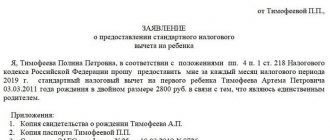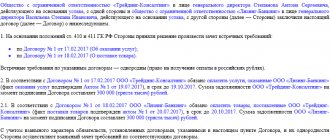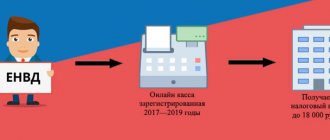Who can provide a deduction for children?
This benefit should be established for every employee who has children under the age of 18.
If they are studying at a higher institution and have the status of cadets, graduate students, students, residents, then the period for obtaining benefits for them is extended to 24 years. You must stop using the deduction starting from the month following the month you stop studying. True, in a situation with education there is an exception - if the child gets married. In addition, the deduction is accrued not only for the natural child, but also for those adopted or in care.
At its core, a deduction is an amount fixed by law by which the personal income tax base is reduced at a rate of 13%. All other incomes that fall under other rates (9%, 30%, etc.) are not subject to benefits.
The deduction is used incrementally from the beginning of the tax period (year). However, the Tax Code sets a limit on income received, after which the deduction ceases to be valid. In 2017, it did not change, and everything was also set in the amount of 350,000 rubles. This restriction means that from the month in which the employee’s earnings reached the specified amount, the benefit is canceled.
Attention! The Tax Code provides for the possibility for the second parent to double the benefits if the first parent is absent. This means death or recognition of him as missing. To receive a double benefit, you must provide documents confirming this status.
However, once a parent who was classified as single remarries, he or she automatically loses the double benefit. But if the marriage is dissolved again in the future, then you can again obtain the right to double benefits, but only under one condition - during the marriage, the child was not adopted by the second parent.
You can also renounce your benefit in favor of doubling it for the second parent. This opportunity can be used if one of the parents currently has no income. The one who makes the refusal must put it in writing, and also take a certificate from his workplace stating that he is not currently using the benefit.
However, it is impossible to issue a refusal in the following cases:
- The parent who wants to refuse is not employed at the time of refusal;
- Is on maternity leave or maternity leave;
- Registered with the employment center.
Attention! The accountant must be extremely careful when determining the right to benefits for divorced parents. They can only be provided in a situation where the parent actually participates in financing the child. For example, this can be confirmed by a document confirming the transfer of alimony.
https://youtu.be/YxnhmaSg7aE
Tax deduction amount in 2020
| Number of children and their status | Deduction amount, in rubles |
| One child | 1 400 |
| For the second child | 1 400 |
| On the third and subsequent | 3 000 |
| For a child with a disability | 12 000 |
| Guardian or adoptive parents of a disabled child | 6 000 |
Depending on the number of children in the family, the tax deduction may increase. So for the first 1-2 children, this amount is 1,400 rubles; with the appearance of a third child in the family, this amount increases to 3,000 rubles.
This deduction is made from wages from the moment the child is born and ends when he reaches adulthood. In some cases, the tax deduction can be extended until the age of 24. This can happen if the child is a full-time student at an educational institution (institute, technical school, university).
There may be not very favorable moments in life. If this happens and there is a disabled child in the family, then the tax deduction increases to 12,000 rubles, and if you are a guardian, trustee or adoptive parent - 6,000 rubles . The same amounts are provided for a disabled child of group I or II, a full-time student, graduate student, resident, intern or student (up to 24 years old).
But this is not all the important information. Few people know about this, but it is very important to note, some individuals may receive double the amount . Such persons may be one of the parents, the adoptive parent, the guardian, the trustee, as well as the other parent, in the event that one of the parents refused in favor of the other parent.
Example: A citizen has two children. He is officially employed with a salary of 52 thousand rubles, so he can save on income tax for a full 7 months a year until the deduction amount reaches 350 thousand rubles. Every month he will save (1,400 + 1,400) * 13% = 364 rubles. And since both parents have the right to the deduction, the amount of savings per family each month will be 728 rubles.
Amount of child deduction in 2019
The child tax deduction in 2020 is still determined in the Tax Code and is provided under the same conditions as before. No changes have been made in this area.
When determining the amount of the deduction, you must take into account the total number of children of the employee whose income is taxed. The order in which children were born is important. This means that when the oldest child becomes an adult and loses benefits, all younger children continue to receive their benefits at the same rate. The amount of benefits cannot be recalculated.
For example, an employee has 3 children. The eldest turned 18 and lost benefits. However, the amount of 1,400 rubles will still be provided for the middle child, and 3,000 rubles for the youngest child.
Benefits for children are set in the following amounts:
- 1400 rubles - for the child who was born first (code 126).
- 1400 rubles - for a child born second (code 127).
- 3000 rubles - for the third born child and all subsequent ones (code 128).
- 12,000 rubles – deduction for a disabled child of the 1st or 2nd group (code 129).
Attention! However, for the benefit for a disabled person, it matters whether the child is his own child or adopted. In the second case, the deduction is reduced to 6,000 rubles. If parents received a benefit for a disabled person, then it was previously prohibited to add it to the standard deduction. Now the Ministry of Finance has determined in letter No. 03-04-06/15803 dated March 20, 2017 that such deductions can still be summed up.
You might be interested in:
Work injury: classification, severity, compensation, employer liability
For example, the child is the third in the family and has a disability. Parents will now be entitled to a deduction in the amount of 12,000 + 3,000 = 15,000 rubles.
The standard deduction only applies until the employee's income reaches a certain limit. After this, from the month of excess, he is deprived of this right. The maximum amount of deductions per child in 2020 has not changed compared to previous years.
Limits on the use of the child deduction:
| 2017 | 2018 | 2019 |
| RUB 350,000.00 | RUB 350,000.00 | RUB 350,000.00 |
Personal income tax deductions for children in 2020. What is the deduction limit for children in 2020?
An employee has the right to receive a deduction:
- from the month of birth
- from the month of adoption of the child;
- from the month of establishment of guardianship/trusteeship;
- from the month of concluding the agreement on the transfer of the child to a family for upbringing.
The child deduction is provided monthly throughout the calendar year until the employee’s income reaches a certain limit. In 2020, personal income tax deductions for children are provided until the employee’s income reaches the limit of 350,000 rubles.
Important! The limit for personal income tax deduction in 2020 is RUB 350,000.
This means that once income reaches this amount, the employer no longer provides a deduction for the child or children. This limit does not depend on the number of children in the family. It is the same for all employees.
Examples of applying the deduction for children
For one child
The employee receives a salary of 36 thousand rubles per month and she has one child. The calculation will be as follows (36,000 -1,400)*13% = 4,498 rubles, without applying the deduction she will pay 4,680 rubles in personal income tax. Thus, the savings will be 182 rubles per month and 1638 rubles per year. But the lower the salary level, the stronger the impact of applying the deduction.
| Deduction per child | ||||
| Month | Cumulative income, rubles | Personal income tax, without deduction, rubles | Personal income tax, without deduction, rubles | Savings, rubles |
| January | 36 000 | 4 680 | 4 498 | 182 |
| February | 36 000 | 4 680 | 4 498 | 182 |
| March | 36 000 | 4 680 | 4 498 | 182 |
| April | 36 000 | 4 680 | 4 498 | 182 |
| May | 36 000 | 4 680 | 4 498 | 182 |
| June | 36 000 | 4 680 | 4 498 | 182 |
| July | 36 000 | 4 680 | 4 498 | 182 |
| August | 36 000 | 4 680 | 4 498 | 182 |
| September | 36 000 | 4 680 | 4 498 | 182 |
| October | 36,000 (income exceeded base limit) | 4 680 | 4 680 | – |
| November | 36 000 | 4 680 | 4 680 | – |
| December | 36 000 | 4 680 | 4 680 | – |
| Total | 432 000 | 56 160 | 54 522 | 1638 |
For three children
If there are three children in a family, then the first two are entitled to a deduction of 1,400 rubles, and the third - 3,000, in total the tax base can be reduced by 5,800. We get (36,000 – 5800)*13% = 3926. Without deductions, the tax would be 4,680 rubles. The savings per month is 754 rubles, and for the year 6,786 rubles.
| Deduction for three children | ||||
| Month | Cumulative income, rubles | Personal income tax, without deduction, rubles | Personal income tax, without deduction, rubles | Savings, rubles |
| January | 36 000 | 4 680 | 3 926 | 754 |
| February | 36 000 | 4 680 | 3 926 | 754 |
| March | 36 000 | 4 680 | 3 926 | 754 |
| April | 36 000 | 4 680 | 3 926 | 754 |
| May | 36 000 | 4 680 | 3 926 | 754 |
| June | 36 000 | 4 680 | 3 926 | 754 |
| July | 36 000 | 4 680 | 3 926 | 754 |
| August | 36 000 | 4 680 | 3 926 | 754 |
| September | 36 000 | 4 680 | 3 926 | 754 |
| October | 36,000 (income exceeded base limit) | 4 680 | 4 680 | – |
| November | 36 000 | 4 680 | 4 680 | – |
| December | 36 000 | 4 680 | 4 680 | – |
| Total | 432 000 | 56 160 | 49 374 | 6 786 |
For one disabled child
If there is a disabled child in the family, then the amount of the deduction will be larger - 12,000 rubles if he is a natural child and not an adopted child, plus 1,400 standard deduction. In this case, we will receive (36,000 – 12,000-1,400)*13% = 2,938 rubles of income tax. Without applying the deduction it would be 4,680 rubles. The savings per month are already 1,742 rubles, and over the year it will be 15,678 rubles.
| Deduction for a disabled child | ||||
| Month | Cumulative income, rubles | Personal income tax, without deduction, rubles | Personal income tax, without deduction, rubles | Savings, rubles |
| January | 36 000 | 4 680 | 2 938 | 1 742 |
| February | 36 000 | 4 680 | 2 938 | 1 742 |
| March | 36 000 | 4 680 | 2 938 | 1 742 |
| April | 36 000 | 4 680 | 2 938 | 1 742 |
| May | 36 000 | 4 680 | 2 938 | 1 742 |
| June | 36 000 | 4 680 | 2 938 | 1 742 |
| July | 36 000 | 4 680 | 2 938 | 1 742 |
| August | 36 000 | 4 680 | 2 938 | 1 742 |
| September | 36 000 | 4 680 | 2 938 | 1 742 |
| October | 36,000 (income exceeded base limit) | 4 680 | 4 680 | – |
| November | 36 000 | 4 680 | 4 680 | – |
| December | 36 000 | 4 680 | 4 680 | – |
| Total | 432 000 | 56 160 | 42 120 | 15 678 |
Attention! If an employee has purchased housing, then he has the right to return the income taxes paid to the state by submitting a declaration 3-NFD to receive a property deduction.
Personal income tax deductions for children in 2020. Deduction amounts for children in 2020
The amount of the deduction in most cases depends on the type of child (first, second, third, etc.). We have compiled a table that shows the dependence of the size of the deduction on the number of children and on the status of the child.
| Who is the deduction for? | Conditions for providing a deduction | To whom is it provided? | Monthly deduction amount |
| First child | up to 18 years of age or full-time student, graduate student, resident, intern, student, cadet under the age of 24 years | Parent, parent's spouse, adoptive parent, guardian, custodian, foster parent, foster parent's spouse | 1 400 |
| Second child | 1 400 | ||
| Third and every subsequent | 3 000 | ||
| Disabled child | up to 18 years old | Parent, parent's spouse, adoptive parent | 12 000 |
| Disabled child of group I or II | Full-time student, graduate student, resident, intern, student under the age of 24 | ||
| Disabled child | up to 18 years old | guardian, trustee, adoptive parent, spouse of the adoptive parent | 6 000 |
| Disabled child of group I or II | Full-time student, graduate student, resident, intern, student under the age of 24 |
The deduction for the third and each subsequent child is provided regardless of whether the deduction is given for the 1st and 2nd child. This means that if older children have reached 18 years of age or are no longer students, then a deduction is provided for the youngest child in the amount of 3,000 rubles.
Important! A deduction for a disabled child is provided both by order of birth and by disability. For example, if a disabled child is the third in a row, then he is entitled to a deduction in the amount of 15,000 rubles. (12,000 rub. + 3,000 rub.).
Please note that not only common children are counted. For example, if a couple has a child, and they each have one child from their previous marriage who lives with them, then the common child will be the third one for personal income tax deduction.
How to get a child tax deduction in 2019 from an employer
If a citizen is employed and works under an employment contract, then the easiest way for him to receive a deduction is directly from his employer.
To do this, the following documents are submitted to the accounting department to the responsible person:
- Application for tax deduction for a child. It is registered in the accounting department in the name of the director;
- A copy of the document that confirms the right to receive a deduction (a copy of the child’s certificate or adoption certificate);
- Marriage document (copy of certificate, copy of page from passport with stamp);
- If a deduction is requested for a disabled child - a corresponding certificate;
- If the child is studying full-time, a certificate from the university. The Ministry of Finance has determined that the geographical location of the institution does not matter - the child can receive education both in Russia and abroad. In addition, a deduction is provided when studying on a paid basis.
You might be interested in:
Daily allowances for business trips in Russia in 2020: amounts of payments, changes
How to properly fill out an application for a child benefit
If a single parent or guardian receives the deduction, he must also include in the package of documents:
- A copy of the document on the death of the second parent, a certificate recognizing him as missing, etc.;
- Certificate No. 25 to confirm the status of a single mother;
- Confirmation that the single parent has not registered a new marriage.
An accountant usually provides a ready-made template for an application for a child deduction. The employee only needs to enter the total number of children and the requested deduction amount.
Important! It must be remembered that if an employee works not only in his organization at his main place, but also part-time, then he has the right to take advantage of the deduction only for his main job.
What documents are required?
To receive this deduction, it is important to provide certain documents. Here is their list:
- statement;
- child's birth certificate (copy of the document);
- a certificate from an educational institution indicating age - provided once a year if the child is studying;
- marriage certificate if the employee is the spouse of the employee's parent;
- documents on payment of alimony;
- certificate of disability, if necessary;
- document on the transfer of children to be raised in a family (copy);
- certificate of paternity (copy);
- documents that confirm the establishment of guardianship or guardianship (copies).
This deduction is due to each parent, but it may also be that one parent receives a double deduction. This is possible if there is one parent (the other is deceased or not indicated on the marriage certificate), the only guardian or trustee, or one of the parents waives their right (in writing).
They provide a deduction from the month in which the child was born. But if the application is submitted later, the accountant recalculates the personal income tax taking into account the deduction for the entire year. If a parent files a deduction not at the place of work, but at the tax office, it will be necessary to fill out a declaration. And tax officials will check your eligibility for deductions every three months.
How to get a tax deduction for a child in 2019 through the tax office
Sometimes a situation arises that an employee cannot take full advantage of the deductions that are due to his children. This could be, for example, due to an accountant's mistake.
In this situation, it is still possible to receive a deduction. Only the employee will need to independently prepare the necessary package of forms and apply to the tax office with them. This body reviews them and then returns the excessively withheld amount of personal income tax. However, this can only be done after the next calendar year has ended.
It is very important to pay special attention to the preparation of documents. They must not contain errors. In addition, if the package contains copies, then upon delivery you will need to show the originals to the inspector.
The full package of documents for deduction includes:
- Form 3-NDFL. It is filled out for the year when the employee either did not take advantage of the deduction at all or was not provided in full. You can fill out this form manually on a printed form, or print it out on a computer, use special programs, Internet sites;
- The document that establishes the benefit is a copy of the birth certificate or adoption certificate;
- Application for transfer of excess tax to a bank account with its full details;
- Certificates in 2-NDFL format from all organizations where the applicant worked in the specified year;
- A copy of the first and second pages from the applicant’s passport.
Documents can be delivered in person or sent by mail. However, a deadline has been set for this - until April 30 of the current year. After submitting the forms to the inspector, he must complete the verification procedure within three months.
Attention! Further, he is given another 10 days to inform the applicant about the results of the review. If it was decided to make a return, the funds will be credited according to the details from the application within one month.
Social tax benefits
The Tax Code establishes a strict list of social deductions that a citizen can use. However, in fact, you can only receive it after the tax has been paid and the necessary expenses have been made.
Such expenses include:
- Contributions in the form of donations and for charitable purposes;
- Tuition payment;
- Receiving medical services or purchasing medications;
- Transfer of voluntary contributions to non-state pension funds;
- Additional payments for the insurance component of the pension;
- Payment for an independent assessment of your qualifications.
For each deduction, the conditions for its receipt are established (list of documents, maximum return amount, etc.).
What if parents are divorced
Some experts believe that if the parents are divorced, then the one with whom the child is may qualify for a double deduction. However, this is not true. A double deduction means that the child does not have a second parent, and this situation does not arise during a divorce.
This position was voiced by the Ministry of Finance in its letter dated May 12, 2020. It explains that the concept of “sole parent” means his complete absence due to death, missing, declared dead, etc.
In a divorce, both parents are healthy. Therefore, each of them has the right to apply for a standard deduction. However, the one who lives separately must provide confirmation that he is participating in the maintenance of the child. This usually involves paying alimony. Thus, when submitting documents, you must provide a copy of the child’s certificate and a document confirming the payment of child support.
At the same time, the second parent has the right to refuse his deduction in favor of the first. Then the latter will, in fact, receive a double deduction.
Double tax deduction
Many people have heard about the child tax deduction, but few know that some citizens have the opportunity to receive double benefits:
- one parent (adoptive parent/guardian/guardian);
- the second parent, if the first refused this benefit in his favor.
The concept of a single parent is interpreted rather vaguely. In judicial practice, this status is defined for a person caring for a child alone without financial assistance from the second parent due to his death, serious illness, disappearance, etc.
There is no opportunity to refuse a tax deduction in favor of the second parent if:
- he is not employed;
- is registered with the employment service;
- is on maternity leave or childcare leave.
An important point is the deduction for a disabled child in 2020, made by adding the benefit with the amount of the standard child deduction in accordance with birth order. For example, if a disabled child is the second in a row, then his parents will be able to count on a deduction in the amount of 13,400 rubles (adding 1,400 rubles for the first child and 12,000 for a disabled child).










